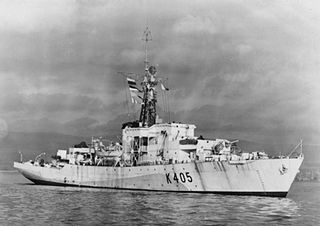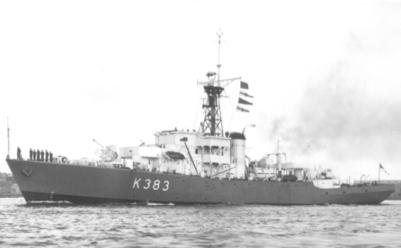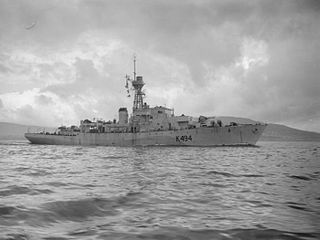
The Castle-class corvettes were an updated version of the much more numerous Flower-class corvettes of the Royal Navy, and started appearing during late 1943. They were equipped with radar as well as ASDIC.

HMS Alnwick Castle was one of 44 Castle-class corvettes built for the Royal Navy during the Second World War. She was named after Alnwick Castle in Northumberland. Completed in late 1944, the ship served as a convoy escort until the end of the war, helping to sink one German submarine. The corvette was placed in reserve after the war and was sold for scrap in 1958.

HMS Flint Castle (K383) was one of 44 Castle-class corvettes built for the Royal Navy during World War II. Completed at the end of 1943, the ship ran aground while training in January 1944. After repairs were completed the following month, she was briefly assigned to the 39th Escort Group for convoy escort duties in the Atlantic Ocean. Flint Castle was transferred to Escort Group B2 in March and screened convoys to and from Gibraltar until September. That month, she joined Escort Group B3 to escort convoys between Canada and Britain and continued to do so until the end of the war in May 1945. The ship then became an anti-submarine training ship in Rosyth and Campbeltown, Scotland, before moving to Portland at the beginning of 1947. Flint Castle remained there until she was taken out of service in March 1956 and broken up beginning in July 1958.

HMS Berkeley Castle was a Castle-class corvette of the United Kingdom's Royal Navy. Built and commissioned in 1943, she escorted convoys from 1944 to 1945. She later served as an air-sea rescue ship until being placed in reserve. Damaged beyond repair in the North Sea flood of 1953 while at a dry dock in Sheerness, she was scrapped a few years later. She was named after Berkeley Castle in Gloucestershire.

HMS Hurst Castle (K416) was one of 44 Castle-class corvettes built for the Royal Navy during World War II. Completed in June 1944, she began escorting convoys in August and was sunk by a German U-boat the following month.

HMS Rising Castle was a Castle-class corvette built for the Royal Navy in World War II. She was named for Castle Rising in Norfolk, England. Before she was commissioned she was transferred to the Royal Canadian Navy and renamed Arnprior and given a new pennant number. After the war she was sold to Uruguay and renamed Montevideo.
When the United States entered World War II at the end of 1941, the United States Navy found itself deficient in ocean escort-type vessels. A crash building program was instituted; but, to meet more immediate needs, the government contracted with shipbuilding firms in England and Canada to build Flower-class corvettes. Vim (PG-99) was one of those British-type escorts. She was launched on 1 April 1943 at the Collingwood Shipyard in Collingwood, Ontario. Nine days later, however, she was transferred to the Royal Navy under the terms of the lend-lease agreement in return for another Flower-class corvette then under construction in Canada. The British renamed her HMS Statice, and she served the Royal Navy under the name through World War II. On 21 June 1946, she was returned to the United States Navy. Though carried on the Navy list as PG-99, the corvette never saw active service with the United States Navy. She was sold on 7 May 1947. To whom she was sold and to what purpose she was put is unknown.
HMCS St. Thomas was a Castle-class corvette of the Royal Canadian Navy. She served during the Second World War in the Battle of the Atlantic, taking part in the sinking of the German U-boat U-877 in 1944. Initially ordered by the British Royal Navy as Sandgate Castle, the ship was transferred to Canada before completion. Following the war, the corvette was converted for mercantile use and renamed Camosun III, then Chilcotin and Yukon Star in 1958 before being broken up in Washington in 1974.

HMS Oakham Castle was a Royal Navy corvette of the Castle class. Built as a convoy escort during the Second World War, it later became a weather ship before being scrapped in 1977.

HMS Nunney Castle was a Castle-class corvette ordered by the British Royal Navy during the Second World War. The ship was transferred to the Royal Canadian Navy before completion and renamed HMCS Bowmanville. Bowmanville served with the Royal Canadian Navy in the final years of the war and was sold for mercantile use in 1946. Renamed Ta Shun, the ship sailed under a Chinese flag, later being renamed Yuan Pei. In 1949, the former corvette was taken over by the Communist-controlled government of China and rearmed and renamed Kuang Chou. Kuang Chou was listed until 1976 and was stricken in 1986.

HMS Hever Castle was a Castle-class corvette constructed for the British Royal Navy in the Second World War. Transferred to the Royal Canadian Navy before completion, the ship was renamed HMCS Copper Cliff and saw service as a convoy escort for the remainder of the war. Following the war, the vessel was sold for mercantile use and renamed Ta Lung, operating under a Chinese flag. In 1949, the ship was taken over by the Communist Chinese government, rearmed and renamed Wan Lee.
HMS Norham Castle, initially named Totnes Castle, was a Castle-class corvette constructed for the British Royal Navy during the Second World War. Before completion, the ship was transferred to the Royal Canadian Navy, renamed HMCS Humberstone, and served the rest of the war as a convoy escort. Following the war, the corvette was sold for mercantile service, beginning as Taiwei in 1946 and ending as South Ocean in 1954. The ship was broken up in 1959.

HMS Woolvesey Castle, also spelled as Wolvesey Castle, was a Castle-class corvette constructed for the British Royal Navy during the Second World War. Before completion, the ship was transferred to the Royal Canadian Navy and was renamed HMCS Huntsville. Huntsville spent the rest of the war as a convoy escort. Following the war, the ship was converted for mercantile use and entered service as SS Wellington Kent in 1947. In 1951, the ship was renamed Belle Isle II. In 1960, Belle Isle II was sunk in a collision.
HMS Tamworth Castle was a Castle-class corvette that was ordered for the British Royal Navy during the Second World War. Before completion, the ship was transferred to the Royal Canadian Navy and renamed HMCS Kincardine, which used the corvette as a convoy escort for the rest of the war. Following the war, the ship was sold for mercantile use to French, then Moroccan interests and was renamed Saada in 1947.
HMS Walmer Castle was a Castle-class corvette constructed for the British Royal Navy during the Second World War. Before completion, the ship was transferred to the Royal Canadian Navy and renamed HMCS Leaside. The corvette was used as an ocean convoy escort during the war and was sold for mercantile use following it. The ship was purchased for use as a passenger ship and renamed Coquitlam, then in 1958,Glacier Queen. In 1970 Glacier Queen was acquired for use as a floating hotel in Alaska. The ship sank in 1978 and was raised and scuttled in Alaskan waters in 1979.

HMS Hedingham Castle was a Castle-class corvette constructed for the Royal Navy during the Second World War. Before being completed, the ship was transferred to the Royal Canadian Navy, renamed HMCS Orangeville and used as a convoy escort for the rest of the war. Following the war, the ship was sold to Chinese interests for mercantile use and renamed Ta Tung in 1946. In 1947, the ship was renamed Hsi Lin before being taken over by Nationalist China in 1951, rearmed and renamed Te An. Te An remained in service until 1967.

HMS Sherborne Castle was a Castle-class corvette constructed for the Royal Navy during the Second World War. Before completion, the ship was transferred to the Royal Canadian Navy and renamed HMCS Petrolia. During the war Petrolia saw service as a convoy escort. Following the war, the corvette was sold for mercantile use and renamed Maid of Athens in 1946 and in 1947, renamed Bharat Laxmi. The ship remained in service until 1965 when Bharat Laxmi was sold for breaking up.

HMS Pembroke Castle was a Castle-class corvette built for the British Royal Navy during the Second World War. Before completion, the ship was transferred to the Royal Canadian Navy and renamed HMCS Tillsonburg. Tillsonburg saw service as a convoy escort during the Second World War in the Battle of the Atlantic. Following the war, the corvette was converted for merchant use and sold to Chinese interests. The ship was renamed Ta Ting in 1946, Chiu Chin in 1947 before being taken over the Nationalist Chinese government in 1951, rearmed and renamed Kao An. The ship remained in service with the Republic of China Navy until being discarded in 1963.

HMS Morpeth Castle was one of 44 Castle-class corvette built for the Royal Navy during the Second World War. She was named after Morpeth Castle in Morpeth. Completed in 1943, she was used as a convoy escort during the war and was scrapped in August 1960.
HMS Tintagel Castle was one of 44 Castle-class corvette built for the Royal Navy during the Second World War. She was named after Tintagel Castle in Tintagel. Completed in 1943, she was used as a convoy escort during the war and was scrapped in August 1960.














